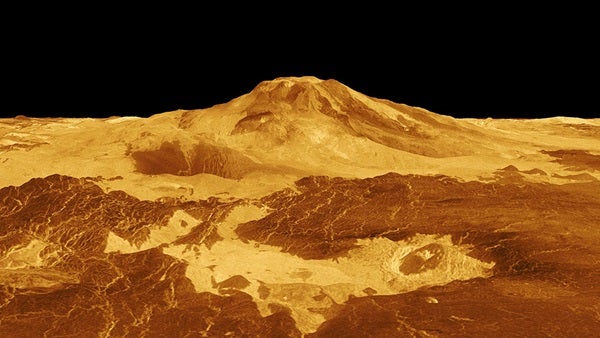
As both NASA and the European Space Agency (ESA) plan missions to Venus, scientists are continuing to learn about our sister planet — including volcanic activity that may be occurring in the present day.
Venus’ landscape is littered with volcanoes that were clearly active in the past. But whether any are still erupting in the present is less clear. Many researchers have suspected this to be the case, and evidence has emerged of lava flows that appear to be relatively recent. But direct evidence of the before-and-after effects of an eruption had not emerged until researchers combed through archival data from NASA’s Magellan mission from the 1990s.
Robert Herrick, a planetary scientist at the University of Alaska in Fairbanks, reexamined the over 30-year-old data and presented the findings last week at the 54th Lunar and Planetary Science Conference in The Woodlands, Texas. Herrick compared radar imagery of the Alta Regio region from February 1991 to data from October of the same year. The area hosts two volcanoes — Maat Mons and Ozza Mons. Looking at the images, he noticed that one volcanic vent near Maat Mons had expanded significantly between datasets. The October data also had a bright feature extending from the vent that looked like a possible lava flow.
Herrick and Scott Hensley, a former Magellan radar team member at NASA’s Jet Propulsion Laboratory (JPL), used computer modeling to compare different geologic scenarios that could cause a square mile-sized (2.2 square kilometers) vent to become misshapen and double in size. The only answer was an eruption.
“Only a couple of the simulations matched the imagery, and the most likely scenario is that volcanic activity occurred on Venus’ surface during Magellan’s mission,” said Hensley in a NASA press release. Hensley argues the finding “confirms there is modern geological activity” on the planet. The results were published March 15 in Science.

A legacy of exploration
Magellan is still considered a smashing success for NASA, having imaged 98 percent of Venus’ surface before being instructed to end its mission by plunging into the planet’s atmosphere and burning up. NASA has plans to continue that legacy with VERITAS (short for Venus Emissivity, Radio science, InSAR, Topography, And Spectroscopy). The spacecraft is meant to create a 3-D map of the surface and identify the composition of the surface using a near-infrared spectrometer. However, the mission recently suffered a setback: Originally scheduled to launch in 2028, it has been delayed to no sooner than 2031 due to workforce and budget constraints as JPL juggles the upcoming Psyche mission to the asteroid of the same name.
NASA is still pressing forward with the Deep Atmosphere Venus Investigation of Noble gases, Chemistry, and Imaging (DAVINCI) mission, which will deploy a lander that will fall through the atmosphere of Venus to examine its terrain up-close. DAVINCI is currently scheduled for a 2029 launch. ESA is also preparing a Venus orbiter called EnVision, which is tentatively set to launch in the early 2030s.









